

Copyright © www.cheekychinchillas.com
Cheeky Chinchillas - Hand Feeding Chinchillas
Chinchillas
soon
lose
weight
and
become
dehydrated
if
they
do
not
eat
and
drink
properly,
therefore,
if
your
chinchilla
is
unable
to
eat
by
himself
through
illness,
dental
problems
or
an
operation,
it
is
necessary
for
you
to start hand feeding for a while. You will also have to give him water if he is not drinking
He
may
have
had
a
tooth/teeth
filed,
which
has
made
his
mouth
sore
and
so
he
is
reluctant
to
eat,
or
he
may
be
eating
very
little
through
illness
or
while
recovering
from
an
operation.
Whatever
the
reason,
it
is
imperative
that
you
feed
your
chinchilla
by
hand,
because
if
chinchillas
do
not
eat
for
a
while,
their
gut
action slows down and can even stop.
Please scroll down to see pictures, food ideas and quality of life.
If
your
chinchilla
has
had
teeth
filed,
for
example,
he
most
probably
will
have
been
given
a
pain
killer
by
the
vet,
so
you
may
find
when
he
gets
home,
he
will
start
eating
straight
away.
Hopefully,
this
will
continue,
but
keep an eye on him, because when the pain killer wears off, he may not want to eat.
You will probably have been given a liquid feed to administer.
This
is
usually
in
the
form
of
'Science
Recovery'
or
'Critical
Care'.
These
are
complete
foods
in
powder
form,
containing
essential
nutrients
for
poorly
chins
or
chinchillas
recovering
from
illness
and/or
operations
etc.
'The
levels
of
protein,
carbohydrates
and
fibre
are
elevated
above
that
of
a
maintenance
diet
as
required
in
higher levels during illness and recovery'.
If
your
chinchilla
is
not
keen
to
take
this
or
perhaps
he
requires
long
term
hand
feeding,
you
can
make
a
mixture yourself by grinding up pellets, hay and maybe add some calcium/mineral/vitamin supplements.
The
easiest
way
of
grinding
pellets,
is
by
using
a
a
coffee
grinder.
Make
sure
it
is
ground
well
and
the
particles
are
very
fine.
Remember,
this
is
to
be
added
to
water
and
must
be
of
a
consistency
that
you
can
syringe into a chinchilla's mouth.
You
may
be
lucky
and
your
chinnie
will
take
the
soft
food
from
a
spoon,
but
if
not,
you
will
have
to
use
either
a
small
plastic
syringe
or
pipette.
It
depends
on
the
food
you
are
using
as
to
which
you
find
easier
to
use.
Sometimes,
a
pipette
is
better
if
the
food
is
a
little
grittier,
but
a
syringe
works
well
when
using
a
smoother
liquid
food.
Sometimes
the
syringe
can
clog
and/or
it
might
squirt
out
-
just
be
careful
this
doesn't
happen
when you are placing it in your chinnies mouth.
I find a 1ml syringe easiest to use.
Always check, to make sure there are no air bubbles in the syringe, before you start feeding.
If
you
are
using
a
1ml
syringe,
remember
this
is
only
a
very
small
amount,
so
make
sure
your
chinnie
is
getting
enough
food.
Obviously,
the
amount
a
chinchilla
will
eat,
varies
on
the
state
of
their
health
at
the
time of feeding and also their weight. Hopefully the amount will increase as the chinnie improves.
Just to give you an example ... I hand fed one of my chinchillas for over 2 years ....
She
could
eat
125mls
plus
of
liquid
feed
a
day
...
but
this
was
my
own
mix
of
ground
up
pellets
with
supplements and she was a big chinchilla.
Remember, this is just an example to give you some idea.
The quantity will depend on the size of the chinchilla and what you are feeding.
'Science
Recovery'
is
a
complete
food
and
more
concentrated,
so
your
chinchilla
will
not
eat
as
much
as
your own mix. It includes high levels of dietry fibre and essential vitamins.
Instructions
on
the
Science
Recovery
packet
suggest
that
you
use
one
sachet
per
Kg
of
body
weight
per
day ALWAYS read the instructions on the packet and if in doubt consult with your vet.
It is best to use some sort of measure to weigh out the ground up food before you add the water.
This way, you will know how much your chinchilla is getting each time.
Hand feeding chinchillas can sometimes be a little difficult and often very messy!
It is a good idea to either sit the chinchilla on a towel on your knee or wear an apron.
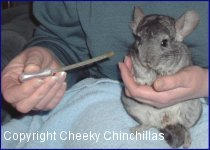
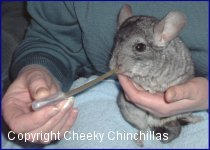
Some chins will accept the situation and take the food without any problems, but many chinnies struggle
to get free and you need a firm hold. Some people wrap their chinchilla in a small towel to keep him still.
Persevere, after a while it becomes much easier.
Before you take hold of your chinchilla to feed, prepare everything first ... it makes the whole operation
a lot easier. Put everything you need ready on a tray; liquid food made up as directed, fresh water
and syringe if he is not drinking, any other medications. It's also a good idea to have some kitchen roll
handy for any spillages.
Make sure everything is within easy reach, before you sit down with your chinchilla and hopefully
it won't be too stressful for either of you
I hope you find this information useful. It can be difficult and sometimes frustrating but it does get easier.
N.B.
About anaesthesia ... all anaesthetics carry a risk with small animals. Your chinchilla may need sedating
to carry out an operation or to have some dental work done.
If your chinchilla is having his incisors (front teeth) burred, your vet will be able to do this while he is awake
and will not require an anaesthetic. If the vet needs to file the molars (back teeth), then he will have to
sedate your chinchilla.Chinchillas' mouths are very small and it would be impossible to carry out dental work
on the back teeth while they are still awake.
There are 2 types of anaesthesia that are generally used: Isoflurane and Sevoflurane.
Sevoflurane has a less pungent/irritating smell which your pet is less likely to resist breathing in and so it is
not as stressful for him. Recovery is also quicker.
Science Recovery and Science Selective Chinchilla are made by Supreme Petfoods Limited
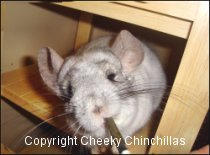
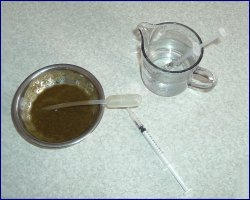
Science Selective Chinchilla is a nutritionally complete and balanced diet
suitable for all chinnies.
The 'crunchy' extruded pellets are easy to hold (easy to grind down) and make a good
alternative for chinnies that have tooth problems and find other pellets hard to eat.
Nutritional Information:
Protein 16.0%, Crude Fibre 19.0%, Fat Content 3.0%, Inorganic Matter 7.0%, Calcium 0.8%, Phosphorus 0.4%
High Fibre – 19%, Zero Added Sugar
Beaphar Care Plus is also an extruded pelleted food for all chinchillas, but again, it could also tempt and
encourage chinchillas with dental problems. I use some of this as a treat for my chinchillas.
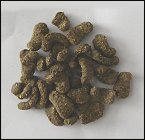

What Beaphar say:
The
Beaphar
Care+
range
is
the
first,
totally
complete,
super
premium
food
available
for
the
small
pet,
offering
the
highest
possible
quality
and
formulation
known
to
man.
The
high
quality
proteins
and
Omega
3
and
6
fatty
acids
ensures
that
an
animal
will
have
a
healthy
and
long
life
with
out
experiencing
the
diseases
caused
by
nutritional
deficiencies.
The
foods
also
contain
prebiotics
and
Yucca
extracts
and
the
chelated
minerals improve absorption and supply to the body.
Remember, as with pellets, any new hay should be introduced slowly.
Quality of Life
When a chinchilla has been ill, has undergone surgery or has had dental issues, he may for a
while, need extra special care and if he is unwilling to eat, he will need to be hand fed, as it is
vital to keep the gut stimulated. Hand feeding is very often necessary when a chinchilla has had
some dentistry work done and he will not eat because his mouth might be sore and he finds it
painful. Hopefully, after hand feeding for a few days/weeks, he will pick up and start eating
again on his own.
Unfortunately, there are times when we have to let our pets go and hand feeding is not the
answer, if the animals are suffering.
When and how do we know if they have some quality of life? Primarily, you will have discussed
this with your vet and hopefully, he or she will have given you some good advice and guidelines.
Also, use common sense, as you know your chinchillas’ behaviour patterns as to what is ‘normal.’
If they do not start eating on their own after some time, what do we do?
Do we continue to hand feed? The answer is definitely yes, if they still have a quality of life.
From my own experience, when a chinchilla can’t or won’t eat on his own, but willingly takes
food via a spoon or syringe, is putting on weight and still wants to come out to play, then I would
say he still has a quality of life.
However, if after a while, your chinchilla is not willingly taking food, he may well be
suffering.How do we know if they are in suffering or in pain? If he is losing weight and you are
literally forcing food down, he just sits around all the time, doesn’t want to come out and he
shows no interest in anything, then his quality of life is poor.
If he has deteriorated so much and you are forcing very small amounts of food into him,you
might be keeping him ‘just alive’. It would probably be kinder to have your pet put to sleep.
This is an awful decision to have to make, but I think we should always remember that we keep
our pets alive for their sake and not for ours
.
© Copyright Cheeky Chinchillas 2000 - 2024
Web Pages, Images and Sound Recordings on this site are copyright.
It is illegal to take any without permission
The content of this site is based upon the experiences of enthusiastic pet owners. The Webmaster cannot be held
responsible for any of the information on the site or for the consequences of any actions taken by anybody relying
upon this information or opinions given.
If your chinchilla is recovering from an operation/dental problems etc but can still manage to eat
hard food, but doesn't seem to be interested in his pellets, you could offer him a little mixed.
I would
NOT
as a rule recommend the use of mixed food (see
Feeding
)
only quality pellets and hay, but
when chinnies are ill it can sometimes help to get them started again.You could even try some other
foods which you might not normally use, for example, a little organic baby food.
Remember, this is for short term, medicinal puposes to get your chinnie eating: a healthy chin should
only be fed quality hay and pellets.
A responsible chin owner knows what a healthy diet should be ...
As I said earlier, if a chinchilla does not eat, the gut slows and he can just give up altogether.
If your chinnie is also having trouble eating hay (this is often the case when they have tooth problems)
try using a softer hay e.g. Spillers 'Readigrass'.



Cheeky Chinchillas
For Owners of pet Chinchillas



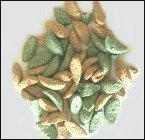

This formula is low in fat, high in roughage and contains Omega 3 and Omega 6 fatty acids.
Cereals, derivatives of vegetable origin, vegetable protein extracts, seeds, minerals, yeasts, vegetables,
Yucca schidigera, algae (Spirulina 0.01%).











































